COLLECTIVE SPORTS
UNIT: HOCKEY
LESSON: 3
Contents:
TACKLING AND SHOOTING
SUPPORTING IN A TRIANGULAR FORMATIONAPPARATUS: Hockey sticks, hockey balls, cones, bands.
ORGANISATION
CONTENT
TEACHING POINTS
Number of players: 6-8, 2 players are receivers positioned at each end-line; the remainders are divided evenly into attackers (A) and defenders (D).
WARM UP; Tackling and shooting
1- Return to Sender
Receivers are allowed to move anywhere along the end-line but not in front of it.
The game begins when either receiver sends a (push-pass) ball out to attackers in the area.
Attackers dribble and pass the ball to one of receivers at the end-lines.
Attackers score 1 point each time they pass the ball to a receiver. The ball is then sent out and the game continues. Play for 2 minutes.
Restart with the ball in the middle.
Swap attackers, defenders and receivers and play again for 2 minutes.
Defenders must try to tackle or intercept the ball to prevent attackers scoring.
Changes to the game:
• Match younger players with similar age players.
• Less experienced players score double points if they pass to either receiver.
• Extend time limit to 3 minutes per attacking side.
• Have uneven sides of attackers and defenders (eg 2 attackers v 3 defenders).
• Replace receivers with 1 or 2 gates so attackers can score with a push-pass.
Easier: Have less defenders. Use more space. Interception only by defenders.
Harder: Have more defenders. Use smaller space. Move end-lines further away and make side-lines.
In partners, one ball between 2 in a space.

MAIN PART:
Skills; tackle
2- Tackle 1 :
Children work in partners. The one who stats (A) pushes the ball through their partner's legs. The ball has to be pushed gently. After that, A moves round his/her partner and traps the ball and pushes it back with a reverse stick. Players then change over roles.
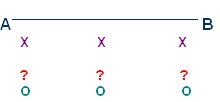
3- Dribbler v tackler.
Children work in partners (defender/tackler and attacker/dribbler). Attackers have to try to reach line AB with the ball. They have 4 attempts each to reach line AB and get 1 point for each successful attempt. Therefore the attacker tries to pull back and then dodge.
Tackler should keep weight on balls of feet and move with control into tackle, stick down.
In partners, 6 to a group.
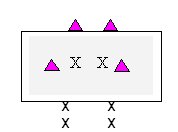
Skills; shooting
4- Shoot from cones:
In a grid 20m x 20m.
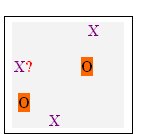
5- 3 v 2
Children are divided in groups of 5; 3 are attackers and 2 are defenders. Attackers have to support each other and try to keep possession with passes, forward, backwards or sideways. They don't have to score. They get a point for every 3 consecutive passes. They must work in a triangle formation.
Defenders have to time their tackle and try to clear out to the side.
Teacher can reduce to 3 v 1 if attack is not successful.
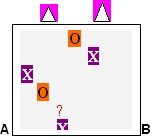
6- 3 v 2
As in the previous lesson (activity 7) aiming in the goals.
Children are divided in groups of 5 and one team of 3 attackers (X) plays against one team of 2 defenders (O). One defender is in the goal. The 3 attackers must pass 3 times before a shot. They have to try to attack in a triangular formation, not in line. The defender tries to tackle and dribble or pass over the line AB. The attacker who has the ball should d raw the defender and time the pass before the tackle.
In a grid 20m x 20m.
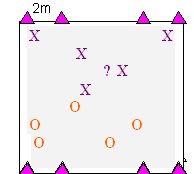
Use pupils to umpire.
GAME;
7- 5 v 5
Children are divided in groups of 5 and one team of 5 plays against another team of 5. Children can decide on the position of the players: 2 attackers, 2 defenders and 1 sweeper. The aim of the game is to score in the opposite goal. It may be played with either one or two sets of goals per team. They have to support each other. This means full concentration is necessary at all times. They have to support in a triangular formation and try to keep possession, giving safe passes, e.g. square, diagonal, back or straight. They must fake and dodge into spaces for a pass and they must not crowd together.
RULES:
• Pass back to start and restart the game.
• Shoot from anywhere push only.
• No lifting or playing the ball in the air.
• No tackling sticks, holding, pushing or kicking.
• A free pass for a foul other players 3m away.
• Defender passes out from 3m if the ball goes off the back line.